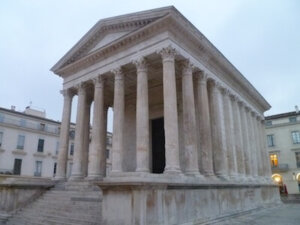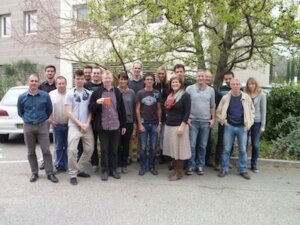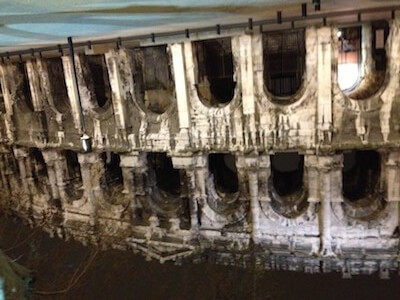 I first visited Nimes, France when I was sixteen, on one of those whirlwind, ten-day, school-organized trips with my French 2 class. What I remembered most about it was the Roman architecture. We spent less than 24 hours there on the way to Avignon. At the time, I would never have guessed that several decades later, I would be back to pay a visit to the world headquarters of Fogale Nanotech, manufacturer of systems and sensors for high precision optical metrology and inspection, as part of Europe in 3D part 2, to learn about more about the company and its play in the 2.5D and 3D IC market.
I first visited Nimes, France when I was sixteen, on one of those whirlwind, ten-day, school-organized trips with my French 2 class. What I remembered most about it was the Roman architecture. We spent less than 24 hours there on the way to Avignon. At the time, I would never have guessed that several decades later, I would be back to pay a visit to the world headquarters of Fogale Nanotech, manufacturer of systems and sensors for high precision optical metrology and inspection, as part of Europe in 3D part 2, to learn about more about the company and its play in the 2.5D and 3D IC market.
At first, I was intrigued that a technology company would be situated in what I remembered to be a small city steeped in history. The city center is only accessible by foot, thanks to the narrow streets; and is dotted with ancient churches and buildings, gardens, fountains, and statues; your standard Old World Charm. At the epicenter of this part of town is its pièce de la résistance, the Arènes amphitheater, under renovation and still in use today for bullfights and rock concerts, and a shining example that Nimes has been influencing 3D architectures for 2000 years. What better location could there be for Fogale?
 Gilles Fresquet, VP, Fogale Nanotech, and director of the semiconductor and optical division, gave me the grand tour upon my arrival, graciously assisting in my secondary purpose on this Europe in 3D Tour; capturing photos of the 3D InCites Awards statue in various locations around the continent to promote the 2014 3D InCites Award Program, and emphasize our global presence. (You can follow the fun on Twitter (Francoisein3D) and the 3D InCites Facebook page) Our tour concluded with dinner at a fabulous modern restaurant, Le Carré D’art, where we dined on local specialties that were delicously prepared and artfully presented. (The dessert even carried on our 3D stacked theme.) The restaurant, I’m told, is a favorite of Fogale’s president and CEO, Patrick Leteurtre.
Gilles Fresquet, VP, Fogale Nanotech, and director of the semiconductor and optical division, gave me the grand tour upon my arrival, graciously assisting in my secondary purpose on this Europe in 3D Tour; capturing photos of the 3D InCites Awards statue in various locations around the continent to promote the 2014 3D InCites Award Program, and emphasize our global presence. (You can follow the fun on Twitter (Francoisein3D) and the 3D InCites Facebook page) Our tour concluded with dinner at a fabulous modern restaurant, Le Carré D’art, where we dined on local specialties that were delicously prepared and artfully presented. (The dessert even carried on our 3D stacked theme.) The restaurant, I’m told, is a favorite of Fogale’s president and CEO, Patrick Leteurtre.
I spent the better part of the next day on site, touring the R&D lab at Fogale, and learning about not only the companies activities in 2.5 and 3D semiconductor packaging, but also about the company’s history, and how it came to have such a diverse portfolio.
 Fogale Nanotech was founded in 1983 by three CEA –Leti scientists; Mr. Foulon, Mr. Gay and Mr Leteurtre; who each took the first two letters of their last name to form the name “Fogale.” In the beginning, the focus was on nuclear and military applications. As experts in capacitive measurement, they developed systems and sensors for high-precision dimensional solutions. Fresquet says Fogale technology can be found everywhere, from giant telescopes assembled on tops of mountains, to particle accelerators buried deep in the ground.
Fogale Nanotech was founded in 1983 by three CEA –Leti scientists; Mr. Foulon, Mr. Gay and Mr Leteurtre; who each took the first two letters of their last name to form the name “Fogale.” In the beginning, the focus was on nuclear and military applications. As experts in capacitive measurement, they developed systems and sensors for high-precision dimensional solutions. Fresquet says Fogale technology can be found everywhere, from giant telescopes assembled on tops of mountains, to particle accelerators buried deep in the ground.
The inspiration for the particle accelerator solution came from Roman engineers and the need for it to be precisely aligned across the river to be structurally sound, explained Fresquet. These early engineers devised a system of placing buckets of water spaced evenly apart across the bridge, connected by pipes through which the water flowed. The goal was to make sure the water was the same level in each bucket across the span, thereby ensuring that the bridge was also level. Fogale has taken this concept to this century, by fabricating sealed metal cylinders containing liquid and a capacitive sensor in the cap that can measure the liquid’s level to 1µm precision accuracy. These cylinders are embedded throughout the structure of particle accelerators (such as the one in Cern), to maintain the precision required for them to function properly.
For the first ten years they were in business, Fogale didn’t provide tools, noted Fresquet. The focus was on providing scientific solutions. One project was for turbo machinery measurement systems to measure resonance frequency of airplane blades. The result was “Capablade” – short for capacitive blade – that combines capacitive technology with optical and interferometry. But the “first success” of Fogale, said Fresquet, was an anticollision system for medical imaging devices enabled by Fogale technology-based capacitive cameras. The goal was to develop “X-ray machines that didn’t crash into patients.” The camera measures the capacitance between the imager and the human body, so that the camera can be postioned as close as possible without touching. (I’ll bet you’ll think about that the next time you have need an X-ray.)
Now, says Fresquet, the company functions in four distinct divisions; Engineering – where everything starts; Optical and Semiconductor; Sensation Technology; and Fogale Interaction Technology (F.I.T) a new subsidiary spin-out due to the success of its latest invention, a no-contact smartphone screen based on a similar capacitive sensor technology used for the anticollision system. (I got to try this, and its really cool. Look for it in future generations of smartphones, tablets and gaming devices.)
While it may seem strange for one company to build both systems and sensors, for Fogale it seems natural. What they’re really known for is their ability to measure just about anything customers present them with. Their goal is to provide the right tool to get the job done.
Now as I speed towards Dresden on the TGV and ICE trains, I’m already looking forward to the next adventure – a return visit to Fraunhofer IZM-ASSID to learn about the new cluster Juergen Wolf has assembled since I visited last. The rest of the week will be filled with DATE 2014. And don’t forget to follow the 3D InCites Award on Twitter and Facebook. Who knows where it will turn up next? ~F.v.T.





















